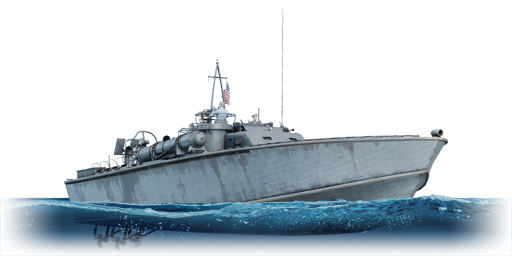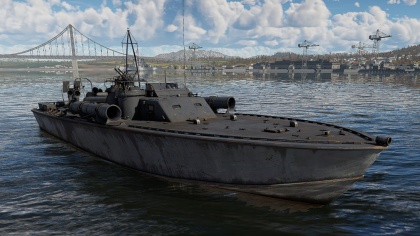Difference between revisions of "PT-103"
CobraKingII (talk | contribs) (→History) (Tag: Visual edit) |
CobraKingII (talk | contribs) (→History) |
||
| Line 48: | Line 48: | ||
== History == | == History == | ||
| − | ''Describe the history of the creation and combat usage of the ship in more detail than in the introduction. If the historical reference turns out to be too big, take it to a separate article, taking a link to an article about the vehicle and adding a block "/ History" (example: <nowiki>https://wiki.warthunder.com/(Vehicle-name)/History</nowiki>) and add a link to it here using the <code>main</code> template. Be sure to reference text and sources by using <code><nowiki><ref></nowiki></code>, as well as adding them at the end of the article.'' | + | <!-- ''Describe the history of the creation and combat usage of the ship in more detail than in the introduction. If the historical reference turns out to be too big, take it to a separate article, taking a link to an article about the vehicle and adding a block "/ History" (example: <nowiki>https://wiki.warthunder.com/(Vehicle-name)/History</nowiki>) and add a link to it here using the <code>main</code> template. Be sure to reference text and sources by using <code><nowiki><ref></nowiki></code>, as well as adding them at the end of the article.'' --? |
| + | |||
| + | '''''PT-103''''' was layed down on January 24, 1942 by the Electric Boat Co., Elco Works, in Bayonne, New Jersey. It was launched on on May 16, 1942, and was completed on June 12, 1942. It entered service as the '''''USS PT-103'''''. | ||
| + | |||
| + | It was assigned to Motor Torpedo Boat Squadron 5 (MTBRon 5), commanded by CDR Henry Farrow, USN. MTBRon 5 was assigned to the Panama Sea Frontier from 1942 to 1943. Afterwards, it was sent to the Solomon Islands where it saw action at a number of locations, including Rendova, Vella Lavella, Treasury, Bougainville, Green, and Emirau. At the end of 1944 the squadron was disbanded, and the ships were distributed between other squadrons to replace lost ships. | ||
| + | |||
| + | The '''''USS PT-103''''' was transferred to Motor Torpedo Boat Squadron 18 (MTBRon 18) under the command of LT Edward MacCauley, III, USNR, on February 15, 1945. MTBRon 18 was assigned to the Southwest Pacific. It saw action at Dreger Harbor, Aitape, Hollandia, Wakde, and Mios Woendi, in New Guinea; at Manus in the Admiralties; and at Morotai in the Halmaheras. The squadron was also temporarily based at Kana Kopa, New Guinea, and later at San Pedro Bay, Philippines. PT-103 was scuttled by American forces on November 4, 1945, at Samar, Philippines. | ||
The ship had a displacement of 56 t, a length of 80 ft, a beam of 20 ft 8 in, and a draft of 5 ft. It was powered by three 3,600 shp Packard W-14 M2500 gasoline engines, and had three shafts. The armament consisted of one single 40 mm mount, four 21" torpedoes, one 37 mm mount (added by the crew on August 1, 1943), one 20mm mount, and two twin .50 cal. machine guns. The crew complement was 17 sailors and officers, and the maximum speed of 41 knots. | The ship had a displacement of 56 t, a length of 80 ft, a beam of 20 ft 8 in, and a draft of 5 ft. It was powered by three 3,600 shp Packard W-14 M2500 gasoline engines, and had three shafts. The armament consisted of one single 40 mm mount, four 21" torpedoes, one 37 mm mount (added by the crew on August 1, 1943), one 20mm mount, and two twin .50 cal. machine guns. The crew complement was 17 sailors and officers, and the maximum speed of 41 knots. | ||
Revision as of 16:12, 23 May 2020
Contents
Description
The Elco 80 ft PT-103 is a rank II American motor torpedo boat
with a battle rating of 1.7 (AB/RB/SB). It was introduced in Update 1.79 "Project X" as part of the fleet closed beta test.
General info
Survivability and armour
Talk about the vehicle's armour. Note the most well-defended and most vulnerable zones, e.g. the ammo magazine. Evaluate the composition of components and assemblies responsible for movement and manoeuvrability. Evaluate the survivability of the primary and secondary armament separately. Don't forget to mention the size of the crew, which plays an important role in fleet mechanics. Tips for preserving survivability should be saved for the "Use in battle" section.
If necessary, use a graphic template to show the most well-protected or most vulnerable points in the armour.
Mobility
Write about the ship’s mobility. Evaluate its power and manoeuvrability, rudder rerouting speed, stopping speed at full tilt, with its maximum forward speed and reverse speed.
Armament
Primary armament
Provide information about the characteristics of the primary armament. Evaluate their efficacy in battle based on their reload speed, ballistics and the capacity of their shells.
Secondary armament
Some ships are fitted with weapons of various calibres. Secondary armament is defined by the weapon chosen with the control Select secondary weapon. Evaluate the secondary armament and give advice on how to use them. Describe the ammunition available for the secondary armament. Provide recommendations on how to use them and which ammunition to choose. Remember that anti-air armament, even heavy calibre weapons, belong in the next section.
Torpedo armament
Many ships are armed with torpedo launchers, and for some vessels such as boats, torpedoes are an extremely important means of defeating an opponent. Evaluate the position of the torpedo launchers, discuss the ammunition available, firing specifics such as dead zones, features of the torpedoes themselves, etc.
Special armament
Depth charges, mines, rocket launchers and missiles are also effective in skilled hands and can be an unexpected surprise for an opponent. Evaluate the ammunition of this type of armament and rate its performance in combat.
Usage in battles
Describe the technique of using this ship, the characteristics of her use in a team and tips on strategy. Abstain from writing an entire guide – don’t get try to provide a single point of view, but give the reader food for thought. Talk about the most dangerous opponents for this vehicle and provide recommendations on fighting them. If necessary, note the specifics of playing with this vehicle in various modes (AB, RB, SB).
Pros and cons
Summarize and briefly evaluate the vehicle in terms of its characteristics and combat effectiveness. Mark its pros and cons in the bulleted list. Try not to use more than 6 points for each of the characteristics. Avoid using categorical definitions such as "bad", "good" and the like - they have a substitution in the form of softer "inadequate", "effective".
Pros:
Cons:





